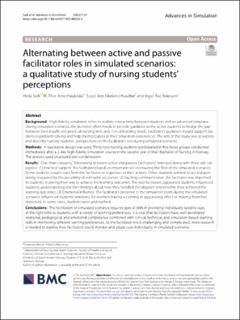| dc.contributor.author | Solli, Hilde | |
| dc.contributor.author | Haukedal, Thor Arne | |
| dc.contributor.author | Husebø, Sissel Iren Eikeland | |
| dc.contributor.author | Reierson, Inger Åse | |
| dc.date.accessioned | 2023-04-03T10:20:51Z | |
| dc.date.available | 2023-04-03T10:20:51Z | |
| dc.date.created | 2022-10-30T18:13:38Z | |
| dc.date.issued | 2022 | |
| dc.identifier.citation | Solli, H., Haukedal, T. A., Husebø, S. I. E., & Reierson, I. Å. (2022). Alternating between active and passive facilitator roles in simulated scenarios: a qualitative study of nursing students’ perceptions. Advances in Simulation, 7(1), 1-8. | en_US |
| dc.identifier.issn | 2059-0628 | |
| dc.identifier.uri | https://hdl.handle.net/11250/3061755 | |
| dc.description.abstract | Background: High-fidelity simulation refers to realistic interactivity between students and an advanced simulator. During simulated scenarios, the facilitator often needs to provide guidance to the active students to bridge the gap between their insufficient practical nursing skills and clinical learning needs. Facilitators’ guidance should support students in problem-solving and help them progress in their simulation experiences. The aim of this study was to explore and describe nursing students´ perspectives on the facilitator’s role during simulated scenarios. Methods: A qualitative design was used. Thirty-two nursing students participated in five focus groups conducted immediately after a 2-day high-fidelity simulation course in the second year of their Bachelor of Nursing in Norway. The analysis used structured text condensation. Results: One main category, “Alternating between active and passive facilitation,” emerged along with three sub-categories: (1) practical support: the facilitator played an important role in ensuring the flow of the simulated scenarios. Some students sought cues from the facilitator or responses to their actions. Other students wanted to act independently, reassured by the possibility of asking for assistance. (2) Guiding communication: the facilitator was important to students in paving their way to achieve the learning outcomes. The way facilitators supported students influenced students’ understanding and their feelings about how they handled the situation and whether they achieved the learning outcomes. (3) Emotional influence: the facilitator’s presence in the simulation room during the simulated scenarios influenced students’ emotions, for example having a calming or aggravating effect or making them feel distressed. In some cases, students were undisturbed. Conclusions: The facilitation of simulated scenarios requires special skills in providing individually suitable cues at the right time to students with a variety of learning preferences. It is vital that facilitators have well-developed relational, pedagogical, and emotional competence combined with clinical, technical, and simulation-based learning skills in monitoring different learning preferences. As the facilitator role is challenging and complicated, more research is needed to explore how facilitators could monitor and adjust cues individually in simulated scenarios. | en_US |
| dc.language.iso | eng | en_US |
| dc.publisher | BMC | en_US |
| dc.rights | Navngivelse 4.0 Internasjonal | * |
| dc.rights.uri | http://creativecommons.org/licenses/by/4.0/deed.no | * |
| dc.title | Alternating between active and passive facilitator roles in simulated scenarios: A qualitative study of nursing students’ perceptions. | en_US |
| dc.type | Peer reviewed | en_US |
| dc.type | Journal article | en_US |
| dc.description.version | publishedVersion | en_US |
| dc.rights.holder | The authors | en_US |
| dc.subject.nsi | VDP::Medisinske Fag: 700 | en_US |
| dc.source.pagenumber | 8 | en_US |
| dc.source.volume | 7 | en_US |
| dc.source.journal | Advances in Simulation | en_US |
| dc.source.issue | 37 | en_US |
| dc.identifier.doi | 10.1186/s41077-022-00233-0 | |
| dc.identifier.cristin | 2066472 | |
| dc.relation.project | SHARE - Centre for Resilience in Healthcare: 5091 | en_US |
| cristin.ispublished | true | |
| cristin.fulltext | original | |
| cristin.qualitycode | 1 | |

